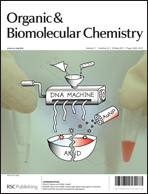Acridine-based macrocyclic fluorescent sensors: self-assembly behavior characterized by crystal structures and a tunable bathochromic-shift in emission induced by H2PO4−via adjusting the ring size and rigidity†
Abstract
In this paper, a series of novel acridine derived bisbenzimidazolium macrocyclic fluorescent sensors were designed and synthesized. X-ray crystal structures demonstrated the self-assembly behavior of these cyclophanes in the solid state driven by hydrogen bond and π–π interactions. Anion binding studies of these sensors revealed a significant effect of the macrocyclic size and rigidity for H2PO4− sensing via the obvious turn-on as well as bathochromic-shift in fluorescence emission. Different cavity size or rigidity of the sensors showed different bathochromic-shifts (from 36 to 126 nm) in fluorescence emission induced by H2PO4−, which resulted in significant color changes of fluorescence from blue to orange red, orange, green and blue-green respectively. The unique fluorescence response toward H2PO4− may be attributed to H2PO4−-induced assembly of sensors forming the excimer between two acridine rings to a different extent.


 Please wait while we load your content...
Please wait while we load your content...